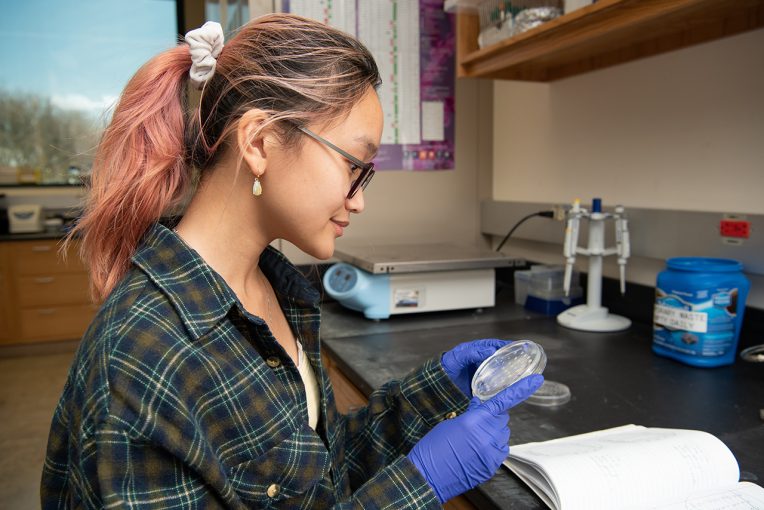Illinois State sophomore Gavin Long has always had an inner-Dr. Alan Grant.
Jurassic Park was the first movie he remembered watching as a child, and—as he put it—dinosaurs were always in his brain. The Steven Spielberg film uncovered his love for science.
“It never really went away,” Long said.
Growing up in Lincoln Woods, Long wanted to go into science—geology in particular—but wasn’t sure how his path would look. If pursuing a college education was an option, he’d have to dedicate quite a bit of time to part-time work for financial support. And that would significantly eat into the time it would take to become deeply invested in scientific study.
Illinois State University has an answer for students such as Long.
In 2018—as part of a working partnership with Heartland Community College and Illinois Wesleyan University, the four-year NexSTEM scholarship became available to students who were Pell Grant eligible. That allowed them to pursue community-based research opportunities in science and mathematics with much of the financial burden lifted.
The National Science Foundation awarded a $4.6 million grant to the three-school consortium on a five-year timeline. Nearly $2.8 million went to scholarships, and the other $1.8 million involved research projects for students who may not have the means to find such opportunities within the field.

“If you look at the STEM population across the U.S., they are not people who come from a low socio-economic background,” said Dr. Sheri Glowinski, director of the NexSTEM program since 2019. “There is still a lot of work to do, and the original team wanted to make STEM accessible to people regardless of what their backgrounds are.”
There are currently 39 students—18 from Illinois State—who are NexSTEM scholars. Recipients get up to $10,000 per year to help cover the costs of higher education. The program is intended to diversify and grow the pool of STEM professionals.
“It’s helped me greatly,” said freshman Amy Le, a biochemistry major from Peoria. Her research project explores the effects of antibiotics on UV radiation. “It covers most of my college tuition, which is why I decided to go to Illinois State, and it made the process of going to college a lot easier because I don’t have to also worry about my financial situation.”
Student applicants must complete a trio of essays explaining their interests in the field, a STEM project they found particularly challenging and their growth from that, and a little bit about themselves. The selection committee is especially interested in students overcoming obstacles. Glowinski said that answer is a strong indicator of problem-solving skills and determination, two vital components in the STEM field.
“I want this to state something. This is going to last longer than my four years.”
NexSTEM Scholarship recipient Tyler Deters
Recipients are then paired with faculty mentors and sometimes other peers to conduct research opportunities that are based on benefiting the community while advancing scientific knowledge. The opportunity also gives students a significant leg up to be able complete research so early on in their college careers. Glowinski said very few schools in the U.S. provide that to incoming students in an authentic way.
Long has been working with Dr. David Malone to try and find rare elements in car batteries. He noted how important it is to find domestic sources since more than 90 percent of those elements are imported from China.
“It’s just a great opportunity to get something under my belt,” Long said. “Any experience is good experience and learning things about geology, maybe I’ll find something I prefer to do and potentially help more people.”
NexSTEM scholars take great pride in being the first recipients of the program. They not only work to advance their own interests and careers, but also to pay it forward for others who faced the same challenges.

Sophomore actuarial sciences major Tyler Deters and Othniel Carr have been looking into trends of the annuity market. “Just seeing the math behind business is kind of cool, and I’m appreciative of that aspect of that project,” Deters explained. Aside from his own project, Deters and a few of his peers have set up tutoring sessions for fellow student mathematicians.
He knows he will forever have NexSTEM scholar attached to his name. He aspires to continue pushing boundaries by not only making the most of his opportunity, but to inspire students behind him.
“I want this to state something,” said Deters, who is from Teutopolis. “This is going to last longer than my four years.”
The NexSTEM committee will ask for an extension of the grant, and Glowinski expects to have 10 more students per school in the upcoming year. COVID-19 has challenged some of the recruiting efforts, but she hopes the program can continue to provide more and more Central Illinois students an opportunity to chase their own visions—whether they are inspired by fictitious dinosaur excursions or something else.
She’s seen remarkable work from the recipients so far and looks forward to watching them grow.
“It is incredibly inspiring to see them embrace this,” she said. “They are embracing all of the course work they are taking and other extra-curriculars. They are doing all of this and still learning in the process. To me, that’s amazing.”
To see research presentations on video, visit NexSTEM’s website.
Check out more scholarship opportunities at Illinois State.

